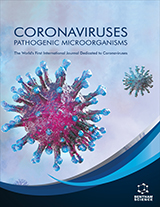Abstract
Background: In the current pandemic of COVID-19, hydroxychloroquine (HCQ) is recommended as an experimental drug for prophylaxis and treatment of the illness. Although it is a safe drug, it can rarely produce a severe drug reaction ‘drug rash with eosinophilia and systemic symptoms syndrome (DRESS)’, and to differentiate it from systemic viral infections is challenging.
Case Presentation: A 45-year old male nurse working in a COVID-19 ward consumed HCQ weekly for two weeks for prevention of SARS-COV-2 illness. He presented with fever, pruritic maculopapular palmar rash, cervical lymphadenopathy for 12 hours and was quarantined as a suspected COVID-19 case. His laboratory tests revealed lymphopenia, eosinophilia, atypical lymphocytes, raised liver enzymes along with IgM negative, IgG positive rapid antibody test of SARS-COV-2. However, his throat swabs for SARS-COV-2 by real-time PCR were negative on day 1 and 7. He was finally diagnosed as definite DRESS based on the RegiSCAR score of six. He responded to levocetirizine 5 mg OD and oral prednisolone 60 mg daily tapered over 7 days.
Conclusion: DRESS due to HCQ is ‘probable’, ‘of moderate severity’, and ‘not preventable’ adverse effect mimicking SARS-COV-2 illness.
Keywords: Hydroxychloroquine, DRESS, drug rash with eosinophilia and systemic symptoms, COVID-19, SARS-COV-2, DRESS syndrome.
Graphical Abstract
[http://dx.doi.org/10.5114/reum.2018.76904] [PMID: 30042604]
[PMID: 22339928]
[http://dx.doi.org/10.1093/jac/dkv018] [PMID: 25693996]
[http://dx.doi.org/10.1016/j.dsx.2020.03.011] [PMID: 32247211]
[http://dx.doi.org/10.1016/j.ijantimicag.2020.105938] [PMID: 32171740]
[http://dx.doi.org/10.1001/jama.2020.6019] [PMID: 32282022]
[http://dx.doi.org/10.1128/AAC.01509-08] [PMID: 19506054]
[http://dx.doi.org/10.1016/S1473-3099(20)30313-3 ]
[http://dx.doi.org/10.1155/2016/4626279] [PMID: 27478650]
[http://dx.doi.org/10.1080/15563650500514558] [PMID: 16615675]
[http://dx.doi.org/10.1093/rheumatology/41.4.473] [PMID: 11961185]
[http://dx.doi.org/10.1542/peds.2015-4497] [PMID: 27245834]
[http://dx.doi.org/10.1001/archderm.138.9.1231] [PMID: 12224986]
[http://dx.doi.org/10.1097/RHU.0000000000000417] [PMID: 28099213]
[http://dx.doi.org/10.1007/s10067-007-0772-1] [PMID: 17952481]
[PMID: 30811149]
[http://dx.doi.org/10.1016/j.amjmed.2011.01.017] [PMID: 21592453]
[http://dx.doi.org/10.1093/jac/dkp236] [PMID: 19570755]
[http://dx.doi.org/10.1111/apt.15731] [PMID: 32222988]
[http://dx.doi.org/10.1111/jdv.16387] [PMID: 32215952]
[http://dx.doi.org/10.1016/S0049-0172(10)80012-5] [PMID: 8278823]
[http://dx.doi.org/10.1016/S1473-3099(06)70361-9] [PMID: 16439323]
[http://dx.doi.org/10.1186/1743-422X-2-69] [PMID: 16115318]
[http://dx.doi.org/10.3947/ic.2015.47.3.155] [PMID: 26483989]
[http://dx.doi.org/10.1093/clinids/8.1.1] [PMID: 3513282]
[http://dx.doi.org/10.1016/S0891-5520(05)70289-0] [PMID: 8698985]
[http://dx.doi.org/10.1155/2016/9453286 ]
[http://dx.doi.org/10.5811/westjem.2010.11.2077] [PMID: 22224160]
[http://dx.doi.org/10.4168/aair.2014.6.3.216] [PMID: 24843796]
[http://dx.doi.org/10.3390/ijms18061243] [PMID: 28598363]
[http://dx.doi.org/10.1186/s13052-018-0535-4] [PMID: 30111350]
[http://dx.doi.org/10.1007/s12098-020-03263-6] [PMID: 32166607]
[http://dx.doi.org/10.1016/j.ijantimicag.2020.105951] [PMID: 32234466]
[http://dx.doi.org/10.1038/clpt.1981.154] [PMID: 7249508]






























